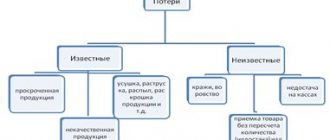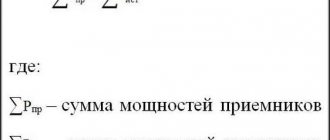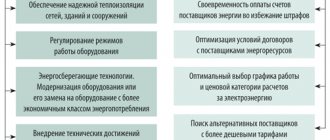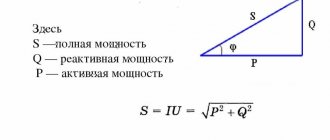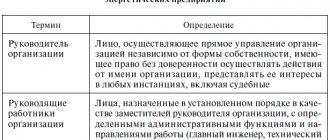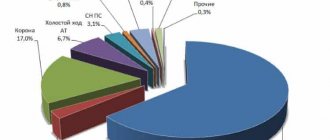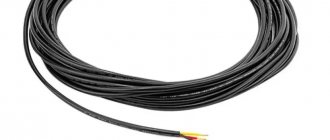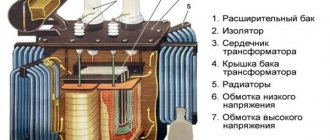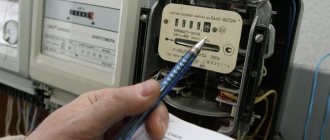What are electrical energy losses?
Electricity losses in a broad sense should be understood as the difference between inputs into the network and actual consumption (useful output). Calculation of losses involves the determination of two quantities, which is performed through accounting for electrical energy. Some are located directly at the substation, others at consumers.
Losses can be calculated in relative and absolute values. In the first case, the calculation is performed in percentages, in the second - in kilowatt-hours. The structure is divided into two main categories due to its occurrence. Total losses are called actual and are the basis for the efficiency of the unit.
Where is the calculation performed?
Calculation of electricity losses in electrical networks is carried out in the following areas:
- For enterprises that generate energy and supply it to the grid. The level depends on production technology, the correctness of determining one’s own needs, and the availability of technical and commercial records. Generation losses are borne by commercial organizations (included in the cost) or added to the standards and actual values for districts or electric network enterprises.
- For high voltage network. Long-distance transmission is accompanied by a high level of electricity losses in lines and power equipment of 220/110/35/10 kV substations. It is calculated by determining the standard, and in more advanced systems through electronic metering devices and automated systems.
- Distribution networks where losses are divided into commercial and technical. It is in this area that it is difficult to predict the level of value due to the complexity of connecting subscribers with modern accounting systems. Losses during the transmission of electricity are calculated on the basis of what is received minus the payment for consumed electrical energy. The technical and commercial parts are determined through the standard.
Types and structure of losses
Losses mean the difference between the electricity supplied to consumers and the energy actually received by them. To normalize losses and calculate their actual value, the following classification was adopted:
- Technological factor. It directly depends on characteristic physical processes, and can change under the influence of the load component, semi-fixed costs, as well as climatic conditions.
- Costs spent on operating auxiliary equipment and providing the necessary conditions for the work of technical personnel.
- Commercial component. This category includes errors in metering devices, as well as other factors causing under-metering of electricity.
Below is an average graph of losses for a typical electric company.
Approximate loss structure
As can be seen from the graph, the highest costs are associated with transmission via overhead lines (power lines), this accounts for about 64% of the total losses. In second place is the corona effect (ionization of air near the overhead line wires and, as a consequence, the occurrence of discharge currents between them) – 17%.
Corona discharge on a power line insulator
Based on the presented graph, it can be stated that the largest percentage of non-targeted expenses falls on the technological factor.
Technical losses: physical causes of occurrence and where they occur
The essence of technical losses lies in the imperfection of technology and conductors used in modern electric power industry. In the process of generating, transmitting and transforming electricity, physical phenomena arise that create conditions for current leakage, heating of conductors or other issues. Technical losses may occur in the following elements:
- Transformers. Each power transformer has two or three windings, in the middle of which is a core. In the process of transforming electricity from more to less, heating occurs in this element, which suggests the occurrence of losses.
- Power lines. When transporting energy over distances, current leaks to the corona for overhead lines, heating the conductors. The calculation of line losses is influenced by the following technical parameters: length, cross-section, specific density of the conductor (copper or aluminum), power loss coefficients, in particular, load distribution coefficient, graph shape coefficient.
- Optional equipment. This category should include technical elements that are involved in the generation, transportation, metering and consumption of electricity. The values for this category are mostly constant or counted through counters.
For each type of electrical network element for which technical losses are calculated, there is a division into no-load losses and load losses. The former are considered a constant value, the latter depend on the level of omission and are determined for the analyzed period, often per month.
An example of determining power losses in a line
Determine the loss of electricity per year in a three-phase overhead line with a voltage of 6 kV, supplying an industrial enterprise with three-shift operation.
Initial data:
- Rated line voltage – Unom. = 6 kV;
- Line length – l = 8.2 km;
- Wire brand - AC95;
- Maximum power transmitted along the line – Pmax. = 830 kW;
- Power factor – cosϕ = 0.8.
Solution
Electricity losses for the designed facility can be calculated in two ways, either by the value of the root-mean-square current Iav taking into account the time the TV line is turned on, or by the maximum current Imax. at loss time τ.
Option I
1. Determine the total active resistance of the line:
R = r0*l = 0.33*8.2 = 2.7 Ohm
where: r0 = 0.33 Ohm/km – active resistance of the AC95 wire, determined according to table 1.11 [L2, p. 17].
2. We determine the annual consumption at maximum load using the expression 4.52 [L1, p. 116]:
W = Tmax.*Pmax. = 6000*830 = 4980*103 kWh
3. We determine the root mean square current, which is an equivalent current that, passing during the time T (day, month, year), causes the same losses of power and electricity as the actual current, changing over the same time, according to expression 4.46-4.47 [L1, p. 115]:
Where:
- kf = 1.05-1.1 – the shape factor is determined with sufficient accuracy for practical calculations according to data from design organizations for any number (more than two) of pantographs with long-term operating mode and the number of pantographs of more than twenty with intermittent-short-term mode.
- TV = 8760 hours – line switching time per year.
4. We determine electricity losses for the year using expressions 4.48 and 4.49 [L1, p. 115]:
5. We determine the losses of active electricity as a percentage:
Option II
The loss of electricity can be determined in another way if the annual electricity consumption is known W = 4980 * 103 kWh.
1. Determine the time of use of the maximum load Tmax. Based on the nature of production and shifts of work of the consumer, it averages per year (hours) according to [L1, p. 116]:
- For lighting loads – 1500 – 2000;
- For single-shift enterprises – 1800 – 2500;
- For two-shift enterprises – 3500 – 4500;
- For three-shift enterprises – 5000 – 7000;
We take Tmax. = 6000 hours – for three-shift enterprises.
2. According to the schedule presented in Fig. 4.8 [L1, p. 116] we determine the loss time τ = 4700 h, based on cosϕ = 0.8 and the time of use of the maximum load Tmax. = 6000 h.
3. We determine the maximum current for the period of time under consideration (day, year) using expression 4.53 [L1, p. 117]:
4. We determine the loss of electricity for the year using expression 4.54 [L1, p. 115]:
As we see in this case, the calculation results coincided, but it may turn out that your calculation results may not differ much from each other, this is due to the error in determining the loss time τ and the shape factor kf.
Literature:
- Power supply for industrial enterprises and installations. Third edition. B.Yu. Lipkin. 1981
- Handbook of power supply design. SOUTH. Barybina. 1990
All the best! See you again on the Raschet.info website.
Commercial losses: the main direction of increasing efficiency in the electric power industry
Commercial losses of electricity are considered a difficult value to predict, since they depend on consumers and their desire to deceive the enterprise or the state. The basis of these problems are:
- Seasonal component. The presented concept includes the underpayment of individuals for actually supplied electrical energy. For example, in the Republic of Belarus, there are 2 reasons for the appearance of the “season” - the availability of tariff benefits and payment not on the 1st, but on the 25th.
- Imperfection of metering devices and their incorrect operation. Modern technical means for determining consumed energy have greatly simplified the task for the subscriber service. But electronics or an incorrectly adjusted accounting system can fail, which causes an increase in commercial losses.
- Theft, underestimation of meter readings by commercial organizations. This is a separate topic for conversation, which involves various tricks of individuals and legal entities to reduce electrical energy costs. All this affects the growth of losses.
Measures to reduce energy losses at home
The list of measures to eliminate energy losses in houses and apartments includes:
- Laying electrical wiring that corresponds to the power consumption will eliminate energy losses, prevent changes in insulation parameters, and prevent excess consumption for heating conductors. Ignoring the requirements of regulatory documentation when installing cable apartments becomes the cause of fires in the premises.
- To avoid bad contacts in switching devices, it is recommended to use products when installing residential electrical networks with elements that are resistant to the oxidation process, moisture and temperature changes. In addition, each contact must have good contact between the poles.
- To remove the reactive load, which is another cause of energy losses, occurs during the operation of electrical appliances and increases the consumption of the active component of electrical energy, it is necessary to use special devices. They are called reactive power compensation units. Their use will reduce energy losses, reduce voltage in various sections of the power grid and the amount of money to pay for the amount of current used.
- Improving lighting systems and replacing incandescent lamps with LED analogues is also a measure accessible to all segments of the population to prevent electricity losses at the end-user level.
- Installing voltage stabilizers will also reduce energy losses in houses and apartments.
Actual losses: total
To calculate actual losses, it is necessary to add up the commercial and technical components. However, the actual calculation of this indicator is carried out differently; the formula for electricity losses is as follows:
Amount of losses = (Receipts to the network – Useful supply – Flows to other energy systems – Own needs) / (Receipts to the network – Lossless – Flows – Own needs) * 100%
Knowing each element, the actual losses are determined as a percentage. To calculate the required parameter in absolute values, it is necessary to perform calculations only for the numerator.
Which consumers are considered lossless and what are flows?
The formula presented above uses the concept of “lossless”, which is determined by commercial metering devices at high voltage substations. An enterprise or organization independently bears the costs of electricity losses, which are taken into account by the meter at the point of connection to the networks.
As for flows, they also refer to lossless flows, although the statement is not entirely correct. In a general sense, this is electrical energy that is sent from one power system to another. Accounting is also carried out using instruments.
Activities for the reconstruction of electrical networks include:
- disaggregation of substations, introduction of additional overhead lines and transformers to unload overloaded (due to economic, not technical conditions!) sections of networks, replacement of lightly loaded transformers at substations (including their movement to other substations), introduction of additional switching devices that provide the ability to switch sections networks for power supply from other substations, etc.;
- commissioning of control units at substations of a network organization;
- introduction of technical means for regulating power flows along lines (transformers with longitudinal-transverse regulation and booster transformers).
Replacing transformers with tap-changers, the switching of taps of which is possible only when the transformer is disconnected from the network, with transformers with on-load tap-changers, the switching of taps of which is also possible under load, is, as a rule, carried out not to reduce losses, but to ensure the required quality of electricity. This usually leads to a concomitant reduction in energy losses. If the quality of electricity was also ensured by a transformer with an on-load tap-changer, and the installation of a transformer with an on-load tap-changer is carried out only for the purpose of reducing losses, then such an installation can be considered an SME. The costs of such work can be recouped by reducing losses if we are talking about a communication transformer for networks of various voltages in a closed network or a transformer in the power center of a radial network of 35–110 kV, but hardly if it is a dead-end transformer of 35–110/10 kV.
Methods for calculating technical losses at electric power enterprises
Electricity losses in electrical networks are carried out using two main methods:
- Calculation and preparation of loss standards, which is implemented through special software, which contains information on the topology of the circuit. According to the latter, standard values are determined.
- Drawing up imbalances for each element of electrical networks. This method is based on the daily, weekly and monthly compilation of balances in high-voltage and distribution networks.
Each option has its own characteristics and effectiveness. It is necessary to understand that the choice of option also depends on the financial side of the issue.
Method for calculating losses in wires - All about electricity
Electricity losses in electrical networks are inevitable, so it is important that they do not exceed an economically justified level. Exceeding technological consumption standards indicates problems that have arisen. To correct the situation, it is necessary to establish the causes of non-target costs and choose ways to reduce them. The information collected in this article describes many aspects of this difficult task.
Calculation of loss standard
Calculation of electricity losses in networks in many CIS countries and Europe is carried out using this methodology. As noted above, the process involves the use of specialized software, which contains standard values and the topology of the electrical network diagram.
To obtain information about technical losses from an employee of the organization, you will need to enter the characteristics of the transmission of active and reactive energy through the feeder, and determine the maximum values for active and reactive power.
It should be noted that the error of such models can reach up to 25% only when calculating electricity losses in the line. The presented method should be treated as a mathematical, approximate value. This reflects the imperfection of the methodology for calculating technical losses in electrical networks.
student Tashim Sh. A. , master's student Sundet G. E.,
senior teacher Smagulova K.K.
Karaganda State Technical University,
The Republic of Kazakhstan
Causes of electricity losses in networks
When transmitting electrical energy, losses occur in each element of the electrical network. To study the components of losses in various elements and nodes of the network, as well as to assess the need for measures aimed at reducing losses, an analysis of the structure of electricity losses is performed.
Actual (reported) electricity losses ΔWot are defined as the difference between the electricity supplied to the network and the electricity supplied from the network to consumers. These losses include components of various natures: losses in network elements that are purely physical in nature, electricity consumption for the operation of equipment installed at substations and ensuring the transmission of electricity, errors in recording electricity by metering devices and, finally, theft of electricity, non-payment or incomplete payment meter readings, etc.
The division of losses into components can be carried out according to different criteria: the nature of losses (constant, variable), voltage classes, groups of elements, production departments, etc. Taking into account the physical nature and specificity of methods for determining quantitative values of actual losses, they can be divided into four components:
1) technical losses of electricity ΔWT, caused by physical processes in wires and electrical equipment that occur during the transmission of electricity through electrical networks.
2) electricity consumption for the auxiliary needs of substations ΔWСН, necessary to ensure the operation of the technological equipment of substations and the life of service personnel, determined by the readings of meters installed on the auxiliary transformers of the substations;
3) electricity losses caused by instrumental errors in their measurement (instrumental losses) ΔWMeas;
4) commercial losses ΔWК caused by theft of electricity, discrepancy between meter readings and payments for electricity by household consumers and other reasons in the area of organizing control over energy consumption. Their value is determined as the difference between actual (reported) losses and the sum of the first three components:
ΔWК=ΔWReport-ΔWT -ΔWСН–ΔWMeas (1)
The first three components of the loss structure are determined by the technological needs of the process of transmitting electricity through networks and instrumental accounting of its receipt and supply. The sum of these components is well described by the term technological losses. The fourth component - commercial losses - represents the impact of the “human factor” and includes all its manifestations: deliberate theft of electricity by some subscribers by changing meter readings, non-payment or incomplete payment of meter readings, etc.
The criteria for classifying a portion of electricity as losses can be of a physical or economic nature.
The sum of technical losses, electricity consumption for the own needs of substations and commercial losses can be called physical losses of electricity. These components are really related to the physics of energy distribution throughout the network. In this case, the first two components of physical losses relate to the technology of transmitting electricity through networks, and the third - to the technology of controlling the amount of transmitted electricity.
Economics defines losses as the part of electricity for which its registered useful supply to consumers turned out to be less than the electricity produced at its power plants and purchased from other producers. At the same time, the registered useful supply of electricity is not only the part of it for which the funds actually arrived in the current account of the energy supply organization, but also the part for which the invoices were issued, i.e. energy consumption is recorded. In contrast, the actual readings of meters recording energy consumption by residential subscribers are unknown. The useful supply of electricity to household subscribers is determined directly by the payment received for the month, therefore all unpaid energy is considered losses.
From an economic point of view, the consumption of electricity for the own needs of substations is no different from the consumption in network elements for transmitting the rest of the electricity to consumers.
Underestimation of the volumes of usefully supplied electricity is the same economic loss as the two components described above. The same can be said about electricity theft. Thus, all four components of losses described above are the same from an economic point of view.
To resolve the situation, specialists need to calculate electrical losses. There are several methods for similar calculations with different accuracy results. The most well-known methods are the average load method, the method of accounting for all hours with the greatest power losses, the calculated day method, and the method of estimating energy losses based on general information data that can indicate network loads.
If maximum accuracy of the results of accounting for all losses is required, you need to use the method of element-by-element calculation of energy losses, using network diagrams and its operating parameters. And as a temporary solution to the problem, many experts use a calculation method that involves a completely random selection of distribution lines.
Naturally, it may not be possible to accurately calculate energy losses the first time, since this work requires certain knowledge and skills. In this case, you can always turn to the services of special companies that help their clients effectively resolve any issues directly related to the technical side of electrical network reconstruction and modernization. Such companies, after carrying out the necessary measures, issue an energy passport for the inspected facility.
Actual losses, i.e. The difference between the electricity supplied to the network and the paid electricity has four components:
— technical losses of electricity caused by physical processes occurring during the transmission of electricity through electrical networks and expressed in the conversion of part of the electricity into heat in network elements;
— electricity consumption for the own needs of substations and melting of ice, necessary to ensure the operation of technological equipment of substations and power lines and the life of maintenance personnel;
— losses of electricity caused by instrumental errors in its measurement (instrumental losses);
— commercial losses caused by theft of electricity, discrepancies between payments for electricity by household consumers and meter readings, delayed payments, non-payment of bills and other reasons in the area of organizing control over energy consumption. Commercial losses do not have an independent mathematical description and, as a result, cannot be calculated autonomously. Their value is determined as the difference between actual (reported) losses and the sum of the first three components, which represent technological losses.
Currently, in the reporting of energy sales enterprises, losses caused by errors in the electricity metering system are included in commercial losses, which is a drawback of the existing reporting system, since it does not provide a clear idea of the structure of losses and appropriate areas of work to reduce them.
Commercial losses of electricity are a manifestation of the “human factor” and have organizational, economic, psychological and legal roots.
Available statistics indicate an almost universal increase in electricity losses. In some energy losses reached 15 - 20% of the useful supply of electricity, and in municipal city and regional electric networks their share is 25 - 50%. The main reason for this situation is the increase in commercial electricity losses, the main share of which falls on electrical networks with a voltage of 0.4 kV.
At the present stage in electrical networks, commercial losses of electricity amount to about 10.25% of the reported ones and directly depend on the level of tariffs and the socio-economic living conditions of the population. Losses from commercial losses only in the electric networks of Karagandy Zharyk LLP are estimated at about 348 million. kWh per year.
Specialists from many energy grid and distribution companies point out special attention to low-voltage electrical networks when analyzing losses during the flow of electrical energy. So, for example, the percentage of total electricity losses for networks of different voltages is given [9]:
— networks with voltage 110 kV and above — 3.68%;
— networks with voltage 6(10) — 35 kV — 23.89%;
- 0.4 kV networks - 72.43%.
The analysis of the dynamics and structure of electricity losses, presented in, indicates an increase in losses in those energy systems where the share of household and small motor loads is significant. If we take into account that commercial losses are concentrated mainly in 0.4 - 10 kV networks and, for objective reasons, the load on 0.4 kV electrical networks will increase due to the rapid growth of household electricity consumption, the share of losses in distribution networks in the coming years will also will grow.
However, reported losses are presented as a value consisting of only two components - technical and commercial losses. At the same time, technical losses include technical losses and electricity consumption for the own needs of substations, and commercial losses include everything else. When rationing losses, commercial losses are understood only as errors in the accounting system, and not other reasons for the influence of the “human factor”. Considering commercial losses through the prism of instrumental losses allows energy sales organizations: firstly, to provide easy reporting when justifying losses, and secondly, to announce the replacement of metering devices with more accurate ones as the main measure to combat commercial losses.
Electricity losses occur in all electrical networks and are a serious problem. According to the electric power industry, if losses during transmission and distribution are no more than 4-5%, then the condition of the networks can be considered satisfactory. An indicator of 10% is considered the maximum permissible. Given the overall huge volumes of electricity supplies, the percentage in physical terms is a very serious figure. This state of affairs is caused by the fact that the level of investment in the field of improving electrical networks has decreased; measures aimed at reducing losses do not have the desired effect. As a result, power supply systems have accumulated a large amount of equipment and accounting tools that are morally and physically obsolete. Much installed equipment does not match the power transmitted through it. Often, huge losses in networks can indicate either the inefficiency of equipment that can become outdated and wear out, or the accumulated problems of old power transmission networks. For specialists, losses that go beyond a certain minimum level should already serve as a signal for technical re-equipment of the complex or for its reconstruction.
Literature:
1. Yu. S. Zhelezko. Standardization of technological losses of electricity in networks - a new calculation methodology. // Electrical engineering news. Information and reference publication. No. 5 (23), 2003.
2. Yu. S. Zhelezko, A. V. Artemyev, O. V. Savchenko. Calculation, analysis and regulation of electricity losses in electrical networks: A guide for practical calculations. - M.: Publishing House NC ENAS, 2005.- 280 p.: ill.
3. V. N. Apryatkin. The human factor and its impact on the level of electricity losses. Report at the conference “Electricity losses in urban electrical networks and technologies for their reduction.” Moscow, “Mosobleelectro”, April 12-15, 2004
4. V. E. Vorotnitsky, M. A. Kalinkina, V. N. Apryatkin. Measures to reduce electricity losses in electrical networks of energy supply organizations // Energy saving. No. 3, 2000.
5. V. E. Vorotnitsky, V. N. Apryatkin. Commercial losses of electricity in electrical networks. Structure and measures to reduce it. // Electrical engineering news. Information and reference publication. No. 4 (16), 2002.
6. V. E. Vorotnitsky. Standard for electricity losses in electrical networks. How to determine and implement it? // Electrical engineering news. Information and reference publication. No. 6 (24), 2003.
7. V. E. Vorotnitsky, M. A. Kalinkina, E. V. Komkova, V. I. Pyatigor. Reducing electricity losses in electrical networks. Dynamics, structure, methods of analysis and measures. // Energy saving. No. 2, No. 3, 2005.
8. V. Demchenko. Proper organization of metering units will reduce commercial electricity losses. // Electrical engineering news. No. 2 (20), 2003.
9. A. Bondarenko. To successfully combat electricity losses, it is necessary to evaluate and analyze them. // Electrical Engineering News. No. 4 (16), 2002.
Calculation software used
Currently, there is a huge amount of software that calculates the technical loss standard. The choice of a particular product depends on the cost of service, region and other important points. In the Republic of Belarus, the main program is DWRES.
The software was developed by a group of scientists and programmers of the Belarusian National Technical University under the leadership of Professor N.I. Fursanov. The tool for calculating the loss standard is specific and has a number of systemic advantages and disadvantages.
For the Russian market, the RPT 3 software, which was developed by specialists from OJSC Scientific and Technical Center of Electric Power Industry, is especially popular. The software is quite good, it performs the assigned tasks, but it also has a number of negative aspects. Nevertheless, the calculation of standard values is carried out in full.
Drawing up unbalances in high-voltage and distribution networks
Technical power losses can be identified through another method. It has already been mentioned above - it is assumed that all high-voltage or distribution networks are connected with metering devices. They help determine the value as accurately as possible. In addition, this technique ensures a real fight against non-payers, theft and misuse of energy equipment.
It should be noted that such an approach, despite its effectiveness, is not applicable in modern conditions. This requires serious measures with high costs for the implementation of tying all consumers with electronic accounting with data transmission (ASCAE).
Electrical leakage at home
The reasons for energy losses after passing through the end-user metering device include:
- excessive current consumption when heating conductors, which occurs when the calculated parameters of electricity consumption are exceeded;
- lack of high-quality contacts in sockets, switches, switches, sockets for installing lamps that provide artificial illumination of rooms and other switching devices;
- capacitive and inductive nature of the load on the end-user distribution network;
- use of outdated models of household appliances that consume large amounts of electricity.
How to reduce technical losses: methods and solutions
The following areas help reduce losses in lines and transformer substations:
- Correctly selected equipment operating mode and capacity utilization affect load losses. That is why the dispatcher is obliged to choose and maintain the most acceptable operating mode. It is important to include the selection of normal break points, calculations of transformer load, and so on in the presented area.
- Replacement of equipment with new equipment that has low idle speed or copes better with load losses. For power lines, it is planned to replace wires with a larger cross-section and use insulated conductors.
- Reduced equipment maintenance time, which leads to reduced energy consumption for own needs.
Measures to improve the electricity metering system include:
- replacement of instrument transformers with transformers with increased accuracy classes and rated parameters corresponding to actual loads;
- replacement of existing electricity meters with new devices with improved characteristics;
- installation of technical electricity metering devices on radial lines extending from substations (head metering).
Measures to reduce electricity theft include:
- periodic inspections of the operating conditions of consumers' electricity meters and detection of electricity theft;
- replacement of conventional “bare” aluminum wires on 0.4 kV overhead lines with insulated wires, making it difficult for unauthorized connection to the line.
Reducing the commercial component of losses: modern opportunities
Electricity losses for the commercial part require the use of the following methods:
- Installation of metering devices and systems with less error. At the moment, options with an accuracy class of 0.5 S are considered optimal.
- The use of automated information transmission systems, ASKUE, which are designed to eliminate seasonal fluctuations. Control over readings is a condition for combating theft and underreporting of data.
- Carrying out raids on problem addresses, which are determined through the distribution network balance system. The latter is relevant when connecting subscribers with modern accounting.
- Application of new technologies to determine under-metering of systems with current transformers. Specialized devices recognize the displacement coefficient of the tangent of the electrical energy distribution vector.
Electricity losses in electrical networks are an important indicator that has significant potential for commercial energy business organizations. Reducing actual losses leads to an increase in profits, and this affects profitability. In conclusion, it should be noted that the optimal loss level should be 3-5% depending on the area.
Costs for supporting the operation of substations
This category includes the cost of electrical energy for the operation of auxiliary devices. Such equipment is necessary for the normal operation of the main units responsible for the conversion of electricity and its distribution. Costs are recorded using metering devices. Here is a list of the main consumers belonging to this category:
- ventilation and cooling systems for transformer equipment;
- heating and ventilation of the technological room, as well as internal lighting fixtures;
- lighting of areas adjacent to substations;
- battery charging equipment;
- operational circuits and monitoring and control systems;
- outdoor equipment heating systems, such as air circuit breaker control modules;
- various types of compressor equipment;
- auxiliary mechanisms;
- equipment for repair work, communication equipment, as well as other devices.
